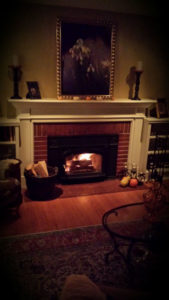 Temperatures are finally starting to cool down and fall finally feels like it’s here! With the busy burning season just around the corner, many homeowners are preparing to light their fireplaces for the first time. Before you use your fireplace for the first time this year, however, make sure to have it inspected first!
Temperatures are finally starting to cool down and fall finally feels like it’s here! With the busy burning season just around the corner, many homeowners are preparing to light their fireplaces for the first time. Before you use your fireplace for the first time this year, however, make sure to have it inspected first!
The importance of chimney inspections
Chimney inspections are an important diagnostic tool that chimney sweeps use to evaluate the condition of your fireplace system.
“A chimney inspection is like an annual dental check-up,” says Ashley Eldridge, Director of Education for the Chimney Safety Institute of America. “It’s preventative maintenance that helps minimize potential hazards.”
Inspections often allow chimney sweeps to identify small areas of damage or deterioration – long before they turn into major chimney problems. This allows small, less expensive repairs to be made as needed instead of needing major masonry or structural repairs all at once.
Three levels of chimney inspections
The National Fire Protection Association created three standardized levels of chimney inspection. Your chimney sweep can help determine what kind of inspection your chimney needs based on age, use, and other factors.
- Level 1 chimney inspections are the most basic; during this type of inspection, the chimney sweep will evaluate all accessible portions of both the interior fireplace and exterior chimney. Level 1 inspections are used in homes where the chimney is regularly maintained, has not been changed since the last inspection, and is not experiencing performance issues.
- Level 2 chimney inspections are more in depth and often involve the use of technology – such as closed circuit cameras – in order to check difficult to reach areas of the chimney such as the flue. Level 2 inspections are common when a new insert has been installed, a new fuel source is being used, or a home is preparing to be bought or sold.
- Level 3 chimney inspections are the most intense and often involve removing part of the masonry or surrounding building material in order to access the chimney; because of this, they are only used in the event of natural disasters, fires, or if the structural stability of the chimney is in question.
What if I don’t use my fireplace?
Regular fireplace maintenance – including chimney sweepings and inspections – are important no matter how often you use your fireplace. In fact, having an inspection done before lighting a fireplace that is seldom used may be even more important. Infrequently used fireplaces are more likely to suffer from problems such as animal entry or debris blockages; because these and other similar issues often present themselves in the form of performance problems, they may not be immediately noticed in a fireplace that is not regularly used.
The National Fire Protection Association and the Chimney Safety Institute of America both recommend that homes have their fireplaces and chimneys inspected at least once per year. Doing this ensures your fireplace is safe to use – no matter how often you use it.
If you are getting ready to start your fireplace for the first time, make sure to have your chimney inspected first. Contact Jack Pixley Sweeps today to schedule your next chimney inspection before you start using your fireplace!
